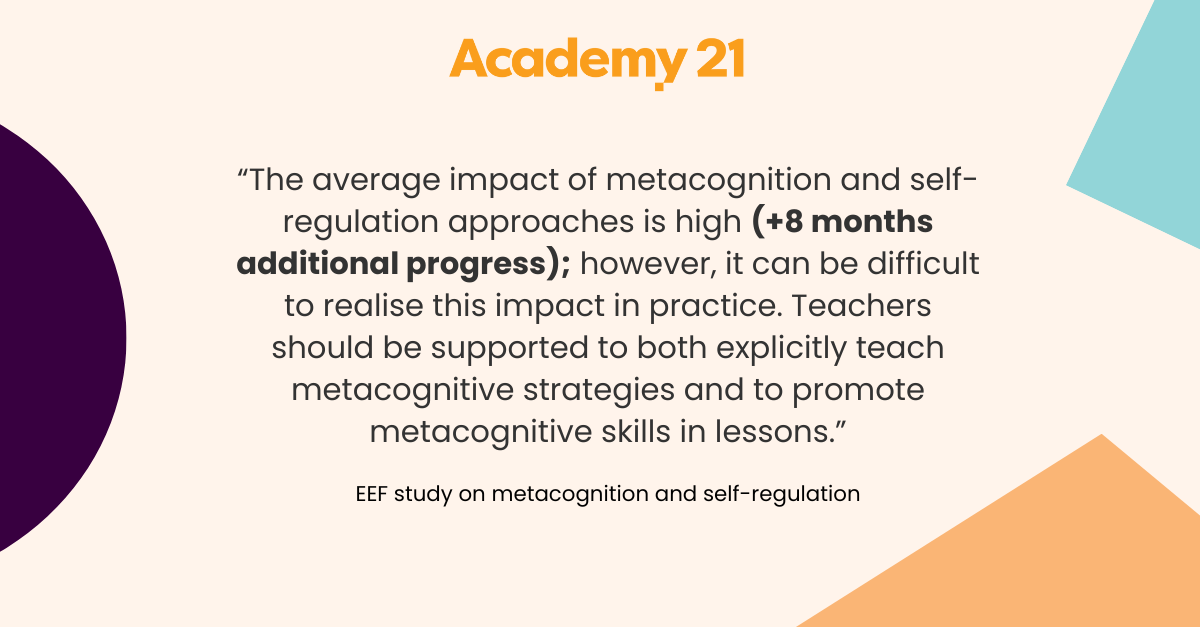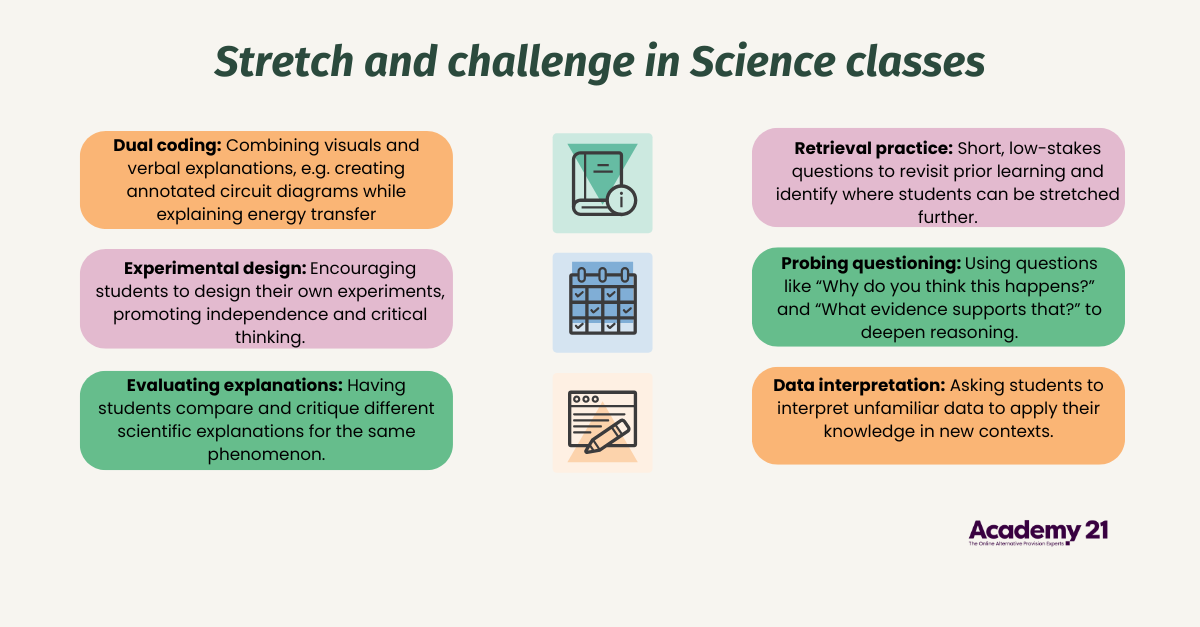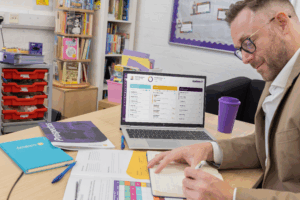Stretch and challenge: How to help students go beyond what they think is possible

Every learner has moments when a task feels just within reach; not easy, but not impossible either. Those moments are where the most powerful learning happens. In education, we refer to this as stretch and challenge: the art of pushing students just far enough to extend their thinking, deepen their understanding, and build their confidence.
At Academy21, stretch and challenge is woven into how teachers design lessons, support students, and celebrate progress. But what exactly does it mean, and why does it matter so much?
What is stretch and challenge?
Planning for stretch and challenge aims to move every learner beyond their comfort zone, no matter where that zone starts. Rather than focusing only on high achievers, a focus on stretch encourages teachers to set the right level of challenge for each student. This takes nimble planning and task structure.
A well-structured challenge should spark curiosity, not anxiety. The goal is to encourage students to think independently, reflect on their learning, and make connections between ideas. In other words, the goal of stretch and challenge isn’t giving students more work but allowing them to think more deeply, to move their thinking forward but not creating excessive new activities.
To make this happen, teachers use a mix of questioning, discussion, and scaffolds to create that sense of productive “struggle”. When students begin to feel the satisfaction of figuring things out for themselves, learning becomes both more meaningful and more memorable. Importantly, the scaffolding used means students are working on the same theme but given the ‘ladder’ to develop their responses and thinking.
The benefits of stretch and challenge: What research tells us
There’s strong evidence that stretch and challenge can make a measurable difference to student outcomes – particularly when it’s tailored to individual learners. Research from the Education Endowment Foundation (EEF) shows that individualised instruction, where challenge is carefully adjusted according to each student’s performance, can lead to around four months of additional academic progress on average.
When tasks are planned to sit just beyond what students can currently do -and are supported through timely feedback and stepped guidance – they strengthen both their knowledge and problem-solving skills.
However, research also makes an important distinction: challenge alone is not enough. The EEF emphasises that individualised and adaptive instruction complements, not replaces, explicit instruction and expert modelling.
This is where metacognition – teaching students to think about their own thinking – plays a crucial role. According to the EEF’s guidance on metacognition and self-regulated learning, explicitly teaching pupils how to plan, monitor, and evaluate their learning can lead to an average of seven to eight months’ additional progress when implemented effectively. The EEF’s evidence suggests that when students understand how they learn, they become more of tackling those complex tasks designed to stretch them.
Crucially, this process builds more than just academic ability. While the strongest research evidence focuses on cognitive gains, the same metacognitive and self-regulation strategies are widely associated with greater confidence, perseverance, and emotional resilience – qualities that help learners view challenges as opportunities rather than threats.

In short, the evidence tells us that effective stretch and challenge offers two interlinked benefits:
- Academic growth – As students engage with increasingly complex material, their conceptual understanding deepens and their capacity for independent thought expands.
- Emotional resilience – As they navigate and overcome challenge, learners build the confidence to take risks, learn from mistakes, and persist through difficulty.
When this balance between demand and support is achieved, learning becomes a shared, active process – not something done to students, but something they do for themselves.
Stretch and challenge in action: Science examples
Science is one of the clearest examples of how stretch and challenge works in practice. Because the subject naturally demands reasoning, exploration, and application, it lends itself well to activities that push students to think beyond surface understanding.
In a typical science lesson, teachers might begin by revisiting core knowledge through retrieval practice – short, low-stakes questions that bring previous learning back to mind. This not only reinforces memory but also gives teachers a quick snapshot of where each student is ready to be stretched.
From there, the challenge builds. Students might be asked to interpret unfamiliar data, design their own experiments, or evaluate competing explanations for a scientific phenomenon. Teachers use probing questions such as “Why do you think this happens?” and “What evidence supports that?” to move students from recalling facts to reasoning with them.

To make abstract concepts more accessible, teachers may also use a technique called dual coding, which essentially means combining visuals and verbal explanation. For example, when studying electricity, students might create annotated circuit diagrams while explaining energy transfer in their own words. This dual process strengthens understanding and allows the teacher to assess conceptual depth in real time.
Collaboration also plays a role. In breakout rooms, students take on specific roles within group tasks, such as hypothesis tester or evidence checker, giving everyone a defined purpose. This ensures engagement and accountability while mirroring the collaborative inquiry that’s central to real-world science.
Formative assessments remain key. Teachers check understanding continuously, adapting questions or revisiting ideas as needed. This responsiveness is what keeps the challenge at the right level: stretching but never overwhelming.
At Academy21, our live, adaptive online science lessons incorporate all of these techniques, and teachers know how to strike the right balance so students can progress in a way that feels natural and comfortable to them. We also use a lot of other multimedia and interactive resources to teach science and make learning engaging.
Overcoming barriers to implementing stretch and challenge
Of course, delivering stretch and challenge consistently isn’t easy. Time pressures, large classes, and fixed curricula can make it difficult to personalise learning. In some cases, funding or staffing limitations restrict the kinds of enrichment activities schools can offer. For students with SEN, the challenge is also making learning inclusive. That means thoughtful adaptation – keeping expectations high but offering support in ways that recognise individual differences.
Research suggests that stretch and challenge tends to have the greatest impact in older secondary years, where students have developed stronger self-regulation skills. But with the right scaffolding, younger learners can benefit too. The key is flexibility, trust, and a willingness to meet students where they are.
How Academy21 embeds stretch and challenge
At Academy21, stretch and challenge are built into the rhythm of every lesson. Teachers use adaptive teaching, targeted questioning, and formative feedback to keep each student working at the right level of demand.
Students are encouraged to pause and think about how they’re learning through reflection journals, retrieval practice, and metacognitive discussions. This helps them develop independence and the confidence to tackle more complex ideas.
Technology plays a part, too. Interactive tools and digital assessments allow teachers to identify gaps in understanding quickly, while offering students opportunities to explore topics in different ways. In this environment, challenge feels achievable because support is always within reach.
The result is a classroom dynamic where progress is visible and learning feels purposeful. Students aren’t just keeping up; they’re moving forward, building habits of curiosity and resilience that will serve them well beyond their time with Academy21.
A mindset for learning
Ultimately, stretch and challenge is not just a strategy but a mindset and belief that every student, given the right support, can go further than they thought possible. For teachers, it means being intentional: setting tasks that provoke thought, encouraging reflection, and knowing when to step back. For students, it means embracing the discomfort that often accompanies growth.
At Academy21, this balance of support and challenge helps young people see learning as an active process and become increasingly engaged. If you have any questions about how we teach our live, adaptive lessons, or would like to refer a student to our online alternative provision, please contact our team below.



